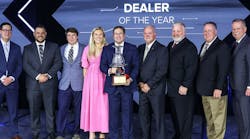The July 2008 installment of The Apparatus Architect discussed some of the more important safety-related components that should be provided on your apparatus fleet. With all of the advances in technology and the increased emphasis on firefighter safety, we must work diligently to design and operate safe apparatus to ensure that "Everyone Goes Home" after each incident. Older apparatus can be upgraded to meet current National Fire Protection Association (NFPA) 1901 standards and new apparatus provides an opportunity to critically evaluate how we operate and improve on any number of safety-related issues by addressing these items through the specification and engineering process.
It's not often that a fire department has the opportunity to acquire two new pieces of apparatus at the same time. The members of the Bedford, VA, Fire Department spent several years evaluating their needs and developing specifications for a new engine and ladder truck, which resulted in two well-thought-out pieces of apparatus to meet the needs of the community.
The Bedford Fire Department protects the City of Bedford and a large portion of Bedford County. The department's first-due response area is over 180 square miles and it responds to more than 900 incidents each year. Under the command of Chief Brad Creasy, the department operates three engines, one ladder truck, a heavy rescue, one tanker and two brush units from a single station in the city. It also operates the ladder company as the rapid intervention team unit on structural fires in a large portion of its coverage area. With Routes 221 and 460 cutting through the first-due area, the department experiences a high number of vehicle accidents as well. In addition, a number of department members are a part of the County Special Operations Command, which is trained in technical rescue and other specialized-hazard mitigation.
The department's older engine companies consisted of a 1988 canopy cab pumper, which was slightly underpowered for the hilly terrain, and a 2000 four-door cab custom pumper equipped with a top-mount pump panel and a large water tank. The department's apparatus committee reviewed past incidents to see what equipment and attack lines were most often used and also visited departments in northern Virginia and Maryland to review newer-model engines that had some of the design characteristics that the department was interested in evaluating. Because of the narrow streets within the city limits and limited access on many of the rural roads and farm lanes, the decision was made to design a short-wheelbase, side-mount pumper with multiple attack lines off the rear for the new apparatus.
The result was a new Seagrave Marauder II pumper with a wheelbase of 182 inches and an overall length of just under 30 feet. Engine 1 is equipped with a 1,500-gpm single-stage pump, 750-gallon, L-shaped water tank, and 475-hp Detroit Diesel motor with a stainless steel cab and body. The engine carries six pre-connected attack lines, a deck gun equipped with smooth-bore tips and a rear hosebed that is 64 inches from the ground. Engine 1 was built with a steel-reinforced front bumper, front down-view mirror, radio headset system for all seating positions, poly rub rails and LED warning lights to enhance crew safety. Chevron striping was provided on the rear body together with a gated rear intake for five-inch supply line. After reviewing the overall design of Bedford Engine 1, it is clear that the department's apparatus committee did its homework in providing a well-thought-out engine company to enhance department operations.
The department's first ladder truck was a used, 100-foot, tractor-drawn ladder that originally saw service with the Richmond, VA, Fire Department. When Richmond embarked on the quint concept, a number of late-model Seagrave tractor-drawn ladder trucks became surplus; one of these trucks was acquired by Bedford in 1998 to initiate truck company service. The used truck provided an opportunity to train personnel on driving a tiller truck together with determining what equipment would be needed to fully implement ladder truck service. One advantage of acquiring a used ladder truck prior to purchasing a new apparatus is that a department can better determine exactly what type of aerial device, ground ladder complement, equipment and associated compartment space will be required to meet the needs of its district without having to expend the funds for a new apparatus.
After running the older tiller truck for a number of years, the Bedford Fire Department began to develop specifications for a new tractor-drawn ladder aerial ladder with a pre-piped waterway and full body compartments on the trailer. The result was a 2007 Seagrave Marauder II tiller equipped with 12 ground ladders totaling 288 feet, a 15-kilowatt hydraulic generator, three saws, three fans, an assortment of forcible-entry tools and a full complement of rapid intervention team equipment. As Ladder 1 serves a large first-due area, it is equipped to act as a back up to the department's heavy rescue with a hydraulic rescue tool, cribbing and other rescue gear.
As with most apparatus projects of any type, there comes a point where the budget money is expended and while there may be other components that you would like to include with the apparatus, the funds are simply not available to include these items. With any new apparatus, your department needs to plan to mount the tools and equipment within the apparatus body. As this is some of the most expensive real estate that you will ever purchase, it is vitally important to properly mount and secure all tools and equipment inside the cab and body compartments of your new apparatus.
After taking delivery of the new Ladder 1, members of the Bedford Fire Department mounted and labeled all of the tools and equipment on the apparatus. Each shelf and tray was marked to indicate where the equipment is located there, including items that are carried in portable tool boxes. It took several weeks to properly lay out each of the compartments and in some cases build tool mounts for each piece of equipment. The time and effort put forth was worthwhile as each piece of equipment has a dedicated location with tools arranged based on frequency of use and tactical operations on the fireground.
The Bedford Fire Department now operates a modern fleet of apparatus that fully meets the needs of the community and the large first-due area that is serviced by the all-volunteer fire company. The time and effort spent by the apparatus committee to carefully develop the specifications and determine tool and equipment locations on both the engine and ladder truck are evident by the overall design of both units.
The next installment of The Apparatus Architect will discuss some design considerations for mobile water supply units and other rural fire apparatus.
TOM SHAND, a Firehouse® contributing editor, is a 33-year veteran of the fire service and works with Michael Wilbur at Emergency Vehicle Response, consulting on a variety of fire apparatus and fire department master-planning issues. He is employed by Seagrave Fire Apparatus LLC as a regional sales manager. MICHAEL WILBUR, a Firehouse® contributing editor, is a lieutenant in the New York City Fire Department, assigned to Ladder Company 27 in the Bronx, and has served on the FDNY Apparatus Purchasing Committee. He consults on a variety of apparatus-related issues around the country. For further information, access his website at





